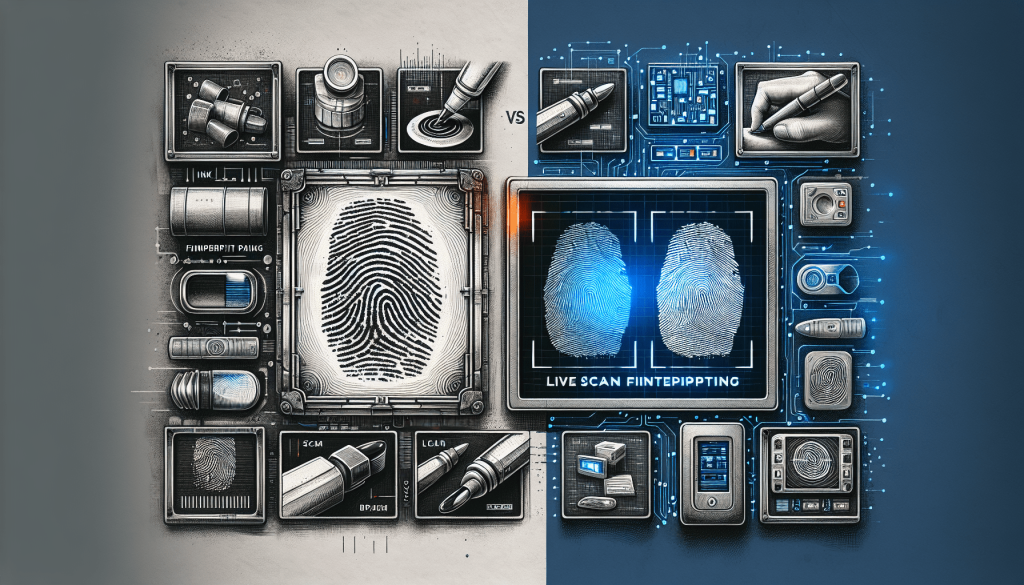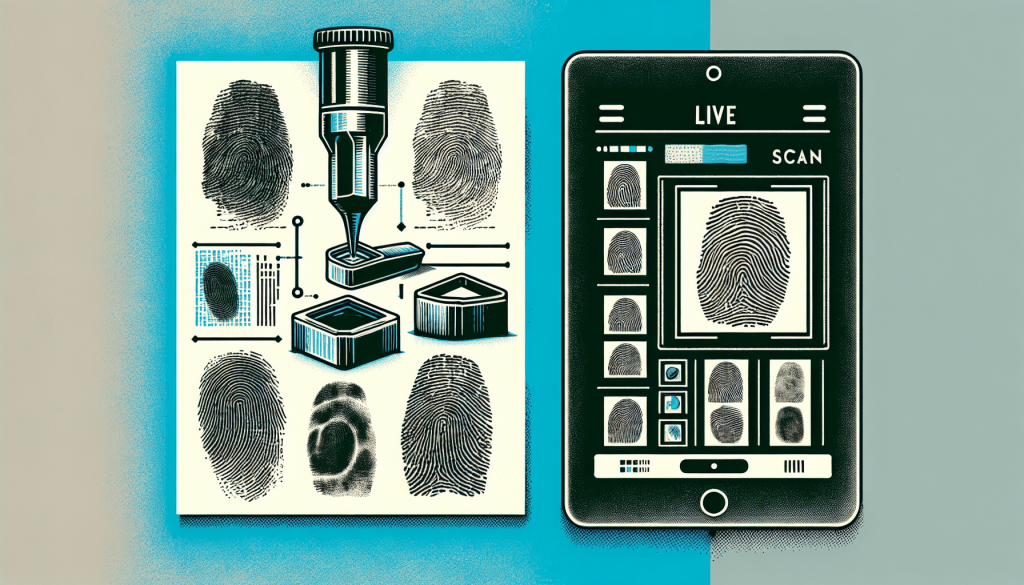In this article titled “What Are The Differences Between Ink Fingerprinting And Live Scan Fingerprinting?”, you’ll discover the key distinctions between these two prevalent methods used to capture fingerprints. You’ll explore how ink fingerprinting, traditionally involving pressing fingers onto an ink pad and then transferring the impression onto paper, contrasts with the modern live scan approach, which utilizes digital technology to produce electronic images of your fingerprints. Each method has its own set of advantages and applications, and by the end of the article, you’ll have a clear understanding of which fingerprinting technique suits different needs and scenarios. Have you ever wondered what sets ink fingerprinting apart from live scan fingerprinting? In an era where identity verification is paramount, the method used to capture your fingerprints can make a significant difference in terms of accuracy, speed, and utility. Whether you’re applying for a job, a visa, or background checks, understanding the nuances between these two fingerprinting methods can be immensely beneficial.
So, let’s dive into the world of fingerprinting and examine the distinctions between ink fingerprinting and live scan fingerprinting in detail.

Understanding Fingerprinting: The Basics
Fingerprinting is a technique used to capture the unique patterns of ridges and valleys on your fingertips. This unique biometric data has been used for over a century for various identification purposes.
Why Fingerprints?
Fingerprints are unique to each individual, including identical twins. This uniqueness makes them an incredibly reliable method for identification and verification across different sectors.
Historical Overview
Fingerprinting has undergone significant transformation over the years. Initially, fingerprints were captured using ink and paper. This method evolved over time and eventually led to the development of digital alternatives like live scan fingerprinting, which offer greater efficiency and accuracy.
Ink Fingerprinting: The Traditional Method
How It Works
Ink fingerprinting, also known as traditional or manual fingerprinting, involves applying ink to each of your fingers and then pressing them onto a fingerprint card. This card is then used for identification and verification purposes.
| Pros | Cons |
|---|---|
| Simple and straightforward | Prone to errors such as smudging |
| Inexpensive to perform | Time-consuming |
| Widely accepted and recognized | Requires physical storage of cards |
Key Processes
- Ink Application: Your fingers are rolled in ink to ensure complete coverage.
- Fingerprint Capture: Each finger is then rolled onto a fingerprint card.
- Verification: The fingerprint cards are usually verified manually and can then be used for identification.
Typical Uses
Ink fingerprinting is still widely used for certain legal, medical, and employment screening processes, particularly in jurisdictions where digital alternatives are not yet implemented.

Live Scan Fingerprinting: The Modern Approach
How It Works
Live scan fingerprinting is a digital method of capturing your fingerprints using an electronic device. You place your fingers on a glass plate, and the scanner captures the image of your fingerprints. This digital image is then transmitted electronically to the concerned authorities.
| Pros | Cons |
|---|---|
| Highly accurate | More expensive to set up |
| Faster processing time | Requires specialized equipment |
| Easy electronic storage and transmission | Limited availability in certain regions |
Key Processes
- Digital Capture: Your fingerprints are scanned using a live scan device.
- Quality Check: The digital system automatically assesses the quality of the fingerprints.
- Electronic Transmission: The captured fingerprints are sent electronically to the designated federal or state agency.
Typical Uses
Live scan fingerprinting is becoming increasingly popular for background checks, professional licensing, and immigration processes due to its speed and accuracy.
Detailed Comparison: Ink Fingerprinting vs. Live Scan Fingerprinting
Now that we have a basic understanding of both methods, let’s delve deeper into the specific differences between ink fingerprinting and live scan fingerprinting.
Accuracy
| Criteria | Ink Fingerprinting | Live Scan Fingerprinting |
|---|---|---|
| Accuracy | Lower | Higher |
| Error Margin | Higher (due to smudging and improper rolling) | Lower (minimal human intervention) |
Accuracy is a critical factor in fingerprinting. Live scan fingerprinting is generally more accurate due to its digital nature and minimal human intervention, which drastically reduces errors compared to ink fingerprinting.
Speed
| Criteria | Ink Fingerprinting | Live Scan Fingerprinting |
|---|---|---|
| Time Taken | 15-30 minutes | 5-10 minutes |
| Processing Time | Several days to weeks | Instantaneous to a few days |
Live scan fingerprinting is significantly faster, both in terms of capturing the fingerprints and processing them. The digital nature allows for quick transmission and processing, whereas traditional ink fingerprinting can be time-consuming.
Cost
| Criteria | Ink Fingerprinting | Live Scan Fingerprinting |
|---|---|---|
| Initial Cost | Low | High |
| Recurring Cost | Low | Moderate |
While the initial cost of setting up live scan systems can be high, the recurring costs may be lower due to reduced need for physical supplies like ink and paper. In contrast, ink fingerprinting has lower initial costs but may incur ongoing costs for supplies.
Accessibility
| Criteria | Ink Fingerprinting | Live Scan Fingerprinting |
|---|---|---|
| Availability | Widely Available | Limited in Some Regions |
| Accessibility | Easy to Perform Anywhere | Requires Specialized Equipment |
Ink fingerprinting is generally more accessible, as it does not require specialized equipment and can be performed almost anywhere. Live scan fingerprinting, however, needs specialized equipment, which may not be widely available in all regions.
Environmental Impact
| Criteria | Ink Fingerprinting | Live Scan Fingerprinting |
|---|---|---|
| Waste Generation | High (Ink and Paper) | Low (Digital Data) |
| Sustainability | Less Sustainable | More Sustainable |
From an environmental perspective, live scan fingerprinting is more sustainable. It minimizes waste by eliminating the need for ink and paper, while ink fingerprinting can generate significant waste.
Use Cases and Legal Acceptability
Ink Fingerprinting
Ink fingerprinting is often used in situations where digital systems are not accessible. This includes:
- Rural and remote areas
- Certain legal proceedings
- Employment screenings in areas without live scan facilities
Live Scan Fingerprinting
Live scan fingerprinting is widely used for:
- Background checks for employment
- Licensing for professionals like nurses and teachers
- Immigration procedures
Regulatory Differences
Different jurisdictions may have varying regulations regarding the acceptability of ink vs. live scan fingerprinting. Always check the specific requirements for your needs.
Tips for Getting Your Fingerprints Taken
For Ink Fingerprinting
- Clean Hands: Ensure your hands are clean but not overly dry, as this can affect the capture.
- Relax: Stay relaxed to ensure good-quality prints.
- Verify: Always double-check the captured fingerprints for clarity before submitting the card.
For Live Scan Fingerprinting
- Hydrate Your Skin: Well-hydrated skin ensures better-quality captures.
- Follow Instructions: Listen carefully to the technician’s instructions.
- Review: Review the digital captures for accuracy before submission.
Future Trends in Fingerprinting
Improved Technology
Advances in technology, such as more sensitive sensors and faster processing systems, are likely to make live scan fingerprinting even more efficient and accurate.
Integration with Other Biometric Systems
Future fingerprinting techniques are likely to be integrated with other biometric systems like facial recognition and iris scanning for robust multi-factor authentication.
Increased Adoption
With the decline in costs and increased accuracy of digital systems, live scan fingerprinting is expected to become more widespread, even in regions where traditional methods are currently prevalent.
Conclusion
Understanding the differences between ink fingerprinting and live scan fingerprinting is crucial for making an informed decision, whether for personal identification purposes or business needs. While ink fingerprinting has its merits, particularly in terms of accessibility and cost, live scan fingerprinting offers unparalleled accuracy, speed, and sustainability.
Both methods have their specific uses and are regulated differently depending on jurisdiction. As technology continues to evolve, we can expect live scan fingerprinting to become even more efficient and accessible. But no matter which method you use, the ultimate goal is to ensure accurate and reliable identification.
So, now that you’re equipped with all this information, the next time you need to get fingerprinted, you’ll know exactly what to expect and how to choose the best method for your needs!

